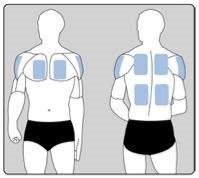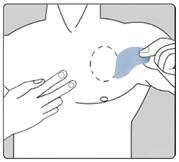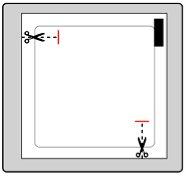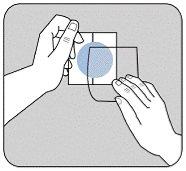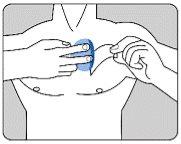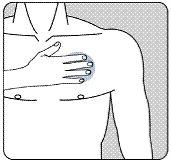
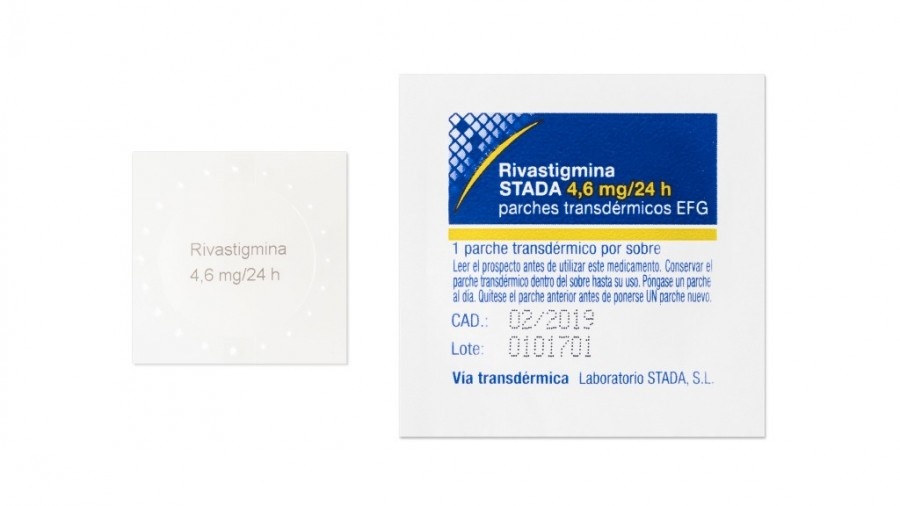
RIVASTIGMINE ARISTO 4.6 mg/24h TRANSDERMAL PATCHES

Ask a doctor about a prescription for RIVASTIGMINE ARISTO 4.6 mg/24h TRANSDERMAL PATCHES

How to use RIVASTIGMINE ARISTO 4.6 mg/24h TRANSDERMAL PATCHES
Introduction
Package Leaflet: Information for the User
Rivastigmine Aristo4.6mg/24h transdermal patchesEFG
Read all of this leaflet carefully before you start using this medicine because it contains important information for you.
- Keep this leaflet, you may need to read it again.
- If you have any further questions, ask your doctor or pharmacist.
- This medicine has been prescribed for you only. Do not pass it on to others. It may harm them, even if their signs of illness are the same as yours.
- If you get any side effects, talk to your doctor or pharmacist. This includes any possible side effects not listed in this leaflet. See section 4.
Contents of the pack:
- What is Rivastigmine Aristo and what is it used for
- What you need to know before you use Rivastigmine Aristo
- How to use Rivastigmine Aristo
- Possible side effects
- Storage of Rivastigmine Aristo
- Contents of the pack and other information
1. What is Rivastigmine Aristo and what is it used for
The active substance of Rivastigmine Aristo is rivastigmine.
Rivastigmine belongs to a group of medicines called cholinesterase inhibitors. In patients with Alzheimer's dementia, certain nerve cells die in the brain, leading to low levels of neurotransmitters such as acetylcholine (a substance that allows nerve cells to communicate with each other). Rivastigmine works by blocking the enzymes that break down acetylcholine: acetylcholinesterase and butyrylcholinesterase. By blocking these enzymes, rivastigmine allows an increase in acetylcholine in the brain, helping to reduce the symptoms of Alzheimer's disease.
Rivastigmine Aristo is used for the treatment of adult patients with mild to moderately severe Alzheimer's dementia, a progressive brain disorder that gradually affects memory, intellectual ability, and behavior.
2. What you need to know before you use Rivastigmine Aristo
Do not use Rivastigmine Aristo
- if you are allergic to rivastigmine (the active substance of Rivastigmine Aristo) or any of the other ingredients of this medicine (listed in section 6).
- if you have ever had an allergic reaction to a similar medicine (carbamate derivatives).
- if you have a skin reaction that spreads beyond the size of the patch, if there is a more intense local reaction (such as blisters, increasing skin inflammation, swelling) and if there is no improvement within 48 hours after removing the transdermal patch.
If you are in any of these situations, inform your doctor and do not use Rivastigmine Aristo transdermal patches.
Warnings and precautions
Consult your doctor before starting to use Rivastigmine Aristo:
- if you have or have ever had any heart problems such as irregular or slow heart rate, QTc prolongation, family history of QTc prolongation, torsades de pointes, or if you have low levels of potassium or magnesium in your blood.
- if you have or have ever had difficulty urinating.
- if you have or have ever had seizures.
- if you have or have ever had asthma or severe respiratory disease.
- if you suffer from tremors.
- if you have low body weight.
- if you have gastrointestinal reactions such as feeling sick (nausea), being sick (vomiting), and diarrhea. You may become dehydrated (lose a large amount of fluid) if vomiting or diarrhea is prolonged.
- if you have liver problems (liver failure).
If you are in any of these situations, your doctor may consider it necessary to monitor you more closely while you are being treated.
If you have not used the patches for more than three days, do not put on another one without consulting your doctor first.
Children and adolescents
Rivastigmine Aristo should not be used in the pediatric population for the treatment of Alzheimer's disease.
Rivastigmine Aristo with other medicines
Tell your doctor or pharmacist if you are using, have recently used, or might use any other medicines.
Rivastigmine Aristo may interfere with anticholinergic medicines, some of which are medicines used to relieve stomach cramps or spasms (e.g., dicyclomine), for the treatment of Parkinson's disease (e.g., amantadine), or to prevent motion sickness (e.g., diphenhydramine, scopolamine, or meclizine).
Rivastigmine Aristo transdermal patches should not be administered at the same time as metoclopramide (a medicine used to relieve or prevent nausea and vomiting). Taking the two medicines together may cause problems such as stiffness in the limbs and hand tremors.
In case you need to undergo surgery while using Rivastigmine Aristo transdermal patches, inform your doctor that you are using it, as it may potentiate the effects of some muscle relaxants used in anesthesia.
Caution should be exercised when using Rivastigmine Aristo transdermal patches with beta-blockers (medicines such as atenolol used to treat high blood pressure, angina, and other heart conditions). Taking the two medicines together may cause complications such as a decrease in heart rate (bradycardia) that may lead to fainting or loss of consciousness.
Caution should be exercised when using Rivastigmine Aristo with other medicines that may affect heart rate or the heart's electrical system (QT prolongation).
Pregnancy, breastfeeding, and fertility
If you are pregnant or breastfeeding, think you may be pregnant, or plan to become pregnant, consult your doctor or pharmacist before using this medicine.
If you are pregnant, it is necessary to evaluate the benefits of using Rivastigmine Aristo against the possible adverse effects for the fetus. Rivastigmine Aristo should not be used during pregnancy unless it is clearly necessary.
You should not breastfeed while being treated with Rivastigmine Aristo transdermal patches.
Driving and using machines
Your doctor will inform you if your illness allows you to drive or use machinery safely. Rivastigmine Aristo transdermal patches may cause dizziness and severe confusion. If you feel dizzy or confused, do not drive or use machinery, or perform other tasks that require your attention.
3. How to use Rivastigmine Aristo
Follow exactly the instructions for administration of Rivastigmine Aristo transdermal patches as indicated by your doctor. In case of doubt, consult your doctor or pharmacist.
IMPORTANT:
- Remove the previous patch before applying a new one.
- Only one patch per day.
- Do not cut the patch into pieces.
- Press the patch firmly against the skin with the palm of your hand for at least 30 seconds.
How to start treatment
Your doctor will indicate the most suitable dose of Rivastigmine Aristo transdermal patch for your case.
- Treatment is usually started with Rivastigmine Aristo 4.6 mg/24 h.
- The recommended daily dose is Rivastigmine Aristo 9.5 mg/24 h. If this dose is well tolerated, the doctor treating you may consider increasing the dose to 13.3 mg/24 h. (The 13.3 mg/24 h dose cannot be achieved with this product. For the conditions under which this dose should be used, consult other rivastigmine products for which 13.3 mg/24 h transdermal patches are available).
- Wear only one transdermal patch at a time and replace the patch with a new one after 24 hours.
During treatment, your doctor may adjust the dose depending on your individual needs.
If you have not used the patches for more than three days, do not put on another one without consulting your doctor first. Treatment with the transdermal patch can be restarted at the same dose if treatment is not interrupted for more than three days. Otherwise, your doctor will have you restart your treatment with Rivastigmine Aristo 4.6 mg/24 h.
Rivastigmine Aristo transdermal patch can be used with food, drink, and alcohol.
Where to apply your Rivastigmine Aristo transdermal patch
- Before applying a patch, make sure the skin is clean, dry, and hairless, without powders, oils, moisturizers, or lotions that may prevent the patch from sticking well to the skin, without cuts, redness, or irritation.
- Remove the existing patch carefully before applying a new one.Wearing multiple patches on your body could expose you to an excessive amount of this medicine, which could be potentially dangerous.
- Apply only onepatch per day to only oneof the possible areas as shown in the following diagrams:
- upper left orupper right arm
- upper left orupper right chest (avoiding the breasts in women)
- upper left orupper right back
- lower left orlower right back
| . |
Every 24 hours, remove the previous patch before applying a new one to only one of the following possible areas
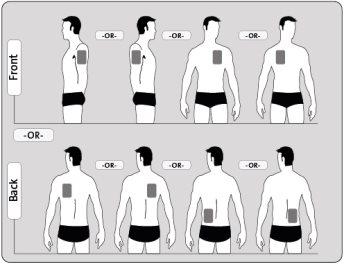
Each time you change the patch, remove the previous day's patch before applying a new patch to a different area of the skin (for example, one day on the right side of the body and the next day on the left side; or one day on the upper part of the body and the next day on the lower part). Wait at least 14 days before applying a new patch to the same area of skin.
How to apply your Rivastigmine Aristo transdermal patch
Rivastigmine Aristo patches are thin, cinnamon-colored plastic patches that stick to the skin. Each patch is in a protective pouch that protects it until you are ready to apply it. Do not open the pouch or remove the patch until you are ready to apply it.
| Remove the existing patch carefully before applying a new one. Patients who are starting treatment for the first time and patients who are restarting treatment with rivastigmine after interrupting treatment should start with the second figure. |
| Each patch is in an individual protective pouch. Only open the pouch when you are ready to apply the patch. Cut the pouch along both scissor marks, without exceeding the indicated line. Tear the pouch to open it. Do not cut the entire length of the pouch to avoid damaging the patch. Remove the patch from the pouch. |
| Remove the skin-colored protective sheet from the top of the patch and discard it. A divided protective sheet, consisting of two sheets, covers the adhesive side of the patch. Remove the first sheet of the protective sheet without touching the adhesive side of the patch with your fingers. |
| Place the adhesive side of the patch on the upper or lower back, on the upper arm, or on the chest, and then remove the second sheet of the protective sheet. |
| Press the patch firmly against the skin with the palm of your hand for at least 30 seconds and make sure the edges are well stuck. |
If it helps, you can write on the patch, for example, the day of the week, with a fine-tip pen.
You should wear the patch continuously until it is time to change it for a new one. When you apply a new patch, you can try different areas to find the ones that are most comfortable for you and where clothing does not rub against the patch.
How to remove your Rivastigmine Aristo transdermal patch
Gently pull one of the edges of the patch to slowly peel it off the skin. If there are any adhesive residues on the skin, soak the area with warm water and mild soap or use baby oil to remove it. Do not use alcohol or other solvents (nail polish removers or other solvents).
After removing the patch, wash your hands with soap and water. In case of contact with the eyes or if the eyes become red after handling the patch, rinse immediately with plenty of water and seek medical advice if the symptoms do not resolve.
Can you wear your Rivastigmine Aristo transdermal patch when bathing, swimming, or exposing yourself to the sun?
- Bathing, swimming, or showering should not affect the patch. Make sure it does not come off partially while performing these activities.
- Do not expose the patch to an external heat source (e.g., excessive sunlight, sauna, solarium) for long periods.
What to do if a patch falls off
If a patch falls off, apply a new one for the rest of that day and change it the next day at the usual time.
When and for how long should you wear your Rivastigmine Aristo transdermal patch?
- To benefit from your treatment, you should apply a new patch every day, preferably at the same time.
- Wear only one Rivastigmine Aristo patch at a time and replace the patch with a new one after 24 hours.
If you use more Rivastigmine Aristo than you should
If you accidentally apply more than one patch, remove all patches from the skin and inform your doctor, or call the Toxicology Information Service, phone: 91 562 04 20 (indicating the medicine and the amount administered). You may need medical attention. Some people who have accidentally taken too high doses of rivastigmine orally have experienced nausea, vomiting, diarrhea, high blood pressure, and hallucinations. There may also be a slowing of the heart rate and fainting.
If you forget to use Rivastigmine Aristo
If you realize you have forgotten to apply a patch, apply it immediately. The next day, apply the next patch at the usual time. Do not apply two patches to make up for the one you forgot.
If you stop treatment with Rivastigmine Aristo
Tell your doctor or pharmacist if you stop using the patches.
If you have any other questions about the use of this medicine, ask your doctor or pharmacist.
4. Possible Adverse Effects
Like all medicines, Rivastigmine Aristo transdermal patches can cause adverse effects, although not all people will experience them.
You may have adverse effects more frequently when starting your treatment or when your dose is increased. Generally, adverse effects will slowly disappear as your body gets used to the medicine.
If you notice any of the following adverse effects that may be serious, remove the patch and inform your doctor immediately:
Frequent(may affect up to 1 in 10 people)
- Lack of appetite
- Dizzy sensation
- Feeling of agitation or numbness
- Urinary incontinence (inability to stop urine properly)
Infrequent(may affect up to 1 in 100 people)
- Heart rhythm problems such as slow heart rate
- Seeing things that do not really exist (hallucinations)
- Stomach ulcer
- Dehydration (loss of a large amount of fluid)
- Hyperactivity (high level of activity, restlessness)
- Aggressiveness
Rare(may affect up to 1 in 1,000 people)
- Falls
Very Rare(may affect up to 1 in 10,000 people)
- Stiffness of the arms and legs
- Tremor in the hands
Unknown(cannot be estimated from the available data)
- Allergic reaction where the patch was applied, such as blisters or skin inflammation
- Worsening of Parkinson's disease signs – such as tremor, stiffness, and difficulty moving
- Pisa syndrome (a condition that involves involuntary muscle contraction and abnormal tilting of the body and head to one side)
- Pancreatitis – signs include pain in the upper part of the stomach, often accompanied by a feeling of dizziness (nausea) or vomiting
- Fast or irregular heart rate
- High blood pressure
- Seizures (convulsions)
- Liver disorders (yellowing of the skin, yellowing of the whites of the eyes, abnormal darkening of urine or unexplained nausea, vomiting, fatigue, and loss of appetite)
- Changes in tests that show liver function
- Feeling of restlessness
- Nightmares
If you notice any of the adverse effects listed above, remove the patch and inform your doctor immediately.
Other adverse effects experienced with rivastigmine capsules or oral solution and that may occur with patches:
Frequent(may affect up to 1 in 10 people)
- Excessive saliva
- Lack of appetite
- Feeling of agitation
- Feeling of general discomfort
- Tremor or feeling of confusion
- Increased sweating
Infrequent(may affect up to 1 in 100 people)
- Irregular heart rate (e.g., fast heart rate)
- Difficulty sleeping
- Accidental falls
Rare(may affect up to 1 in 1,000 people)
- Seizures (convulsions)
- Ulcer in the intestine
- Chest pain – probably caused by spasm in the heart
Very Rare(may affect up to 1 in 10,000 people)
- High blood pressure
- Pancreatitis – signs include severe pain in the upper part of the stomach, often with a feeling of dizziness (nausea) or vomiting
- Gastrointestinal bleeding – manifested as blood in the stool or when vomiting
- Seeing things that do not exist (hallucinations)
- Some people who have been intensely dizzy (vomiting) have had a tear in part of the digestive tube that connects their mouth to their stomach (esophagus)
Reporting of Adverse Effects
If you experience any type of adverse effect, consult your doctor, even if it is a possible adverse effect that does not appear in this prospectus. You can also report them directly through the Spanish Pharmacovigilance System for Human Use Medicines, web: www.notificaRAM.es. By reporting adverse effects, you can contribute to providing more information on the safety of this medicine.
5. Storage of Rivastigmine Aristo
- Keep this medicine out of sight and reach of children.
- Do not use this medicine after the expiration date that appears on the box and on the envelope after CAD/EXP. The expiration date is the last day of the month indicated.
- This medicine does not require special storage conditions.
- Keep the transdermal patch in the envelope until use.
- Do not use any patch if you observe that it is damaged or shows signs of tampering.
- After removing a patch, fold it in half with the adhesive side facing in and press. After inserting it into the original envelope, when disposing of the patch, make sure it is out of the reach of children. After removing the patch, do not touch your eyes, and wash your hands well with water and soap. If your household waste is eliminated by incineration, you can throw the patch in your household trash. If not, take the used patches to the pharmacy, preferably in the original packaging.
Medicines should not be thrown down the drain or into the trash. Deposit the packaging and medicines you no longer need in the SIGRE Point of the pharmacy. In case of doubt, ask your pharmacist how to dispose of the packaging and medicines you no longer need. This way, you will help protect the environment.
6. Package Contents and Additional Information
Composition of Rivastigmine Aristo
- The active ingredient is rivastigmine.
Rivastigmine Aristo 4.6 mg/24 h transdermal patch:
Each transdermal patch releases 4.6 mg of rivastigmine in 24 hours, measures 4.6 cm2, and contains 6.9 mg of rivastigmine.
- The other components are:
Matrix:
- poly [(2-ethylhexyl) acrylate, vinyl acetate]
- polyisobutene of medium and high molecular weight
- anhydrous colloidal silica
- light liquid paraffin
Supporting film:
- polyethylene/thermoplastic resin/polyester film coated with aluminum
Release liner:
- fluoropolymer-coated polyester film
Orange printing ink
Appearance of the Product and Package Contents
Thin transdermal patch. The outer layer is cinnamon-colored and printed with orange ink as follows:
"RIV-TDS 4.6 mg/24 h"
Each envelope contains a transdermal patch. Patches are available in packages containing 7, 30, or 42 envelopes, and in multi-packages containing 60, 84, or 90 envelopes. Only some package sizes may be marketed.
Marketing Authorization Holder
Aristo Pharma Iberia, S.L
c/ Solana, 26
28850– Torrejon de Ardoz
Spain
Manufacturer
Luye Pharma AG
Am Windfeld, 35
83714 Miesbach, Germany
Bluepharma Indústria Farmaceutica, S.A.
Sao Martinho do Bispo
3045-016 Coimbra
Portugal
This medicine is authorized in the Member States of the European Economic Area with the following names:
Germany Demelora 4.6 mg/24 Stunden transdermales Pflaster
Spain Rivastigmina Aristo 4.6 mg/24 h Parches transdérmicos
France Rivastigmine Arrow 4.6 mg/24 heures, dispositif transdermique
Italy Demelora
Netherlands Rivastigmine Aurobindo 4.6 mg/24 uur, pleister voor transdermaal gebruik
Portugal Rivastigmina Bluepharma
Date of the Last Revision of this Prospectus:February 2025
Detailed and updated information on this medicine is available on the website of the Spanish Agency for Medicines and Health Products (AEMPS) http://www.aemps.gob.es/
- Country of registration
- Active substance
- Prescription requiredYes
- Manufacturer
- This information is for reference only and does not constitute medical advice. Always consult a licensed doctor before taking any medication. Oladoctor is not responsible for medical decisions based on this content.
- Alternatives to RIVASTIGMINE ARISTO 4.6 mg/24h TRANSDERMAL PATCHESDosage form: TRANSDERMAL PATCH, 13.3 mg/24 hActive substance: rivastigmineManufacturer: Esteve Pharmaceuticals S.A.Prescription requiredDosage form: TRANSDERMAL PATCH, 4.6 mg/24 hActive substance: rivastigmineManufacturer: Esteve Pharmaceuticals S.A.Prescription requiredDosage form: TRANSDERMAL PATCH, 9.5 mg/24 hActive substance: rivastigmineManufacturer: Esteve Pharmaceuticals S.A.Prescription required
Online doctors for RIVASTIGMINE ARISTO 4.6 mg/24h TRANSDERMAL PATCHES
Discuss dosage, side effects, interactions, contraindications, and prescription renewal for RIVASTIGMINE ARISTO 4.6 mg/24h TRANSDERMAL PATCHES – subject to medical assessment and local rules.




